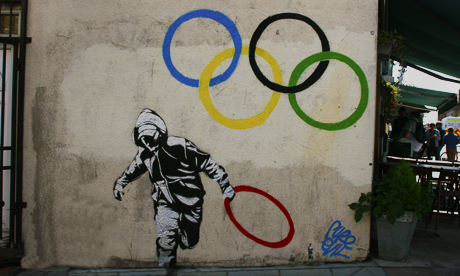London 2012 Hackney Citizens’ Diary: Day 9

Looting the Olympic rings. Photograph: Hackney Citizen
On the anniversary of the day the riots kicked off in Hackney, the borough reflects on the disturbances in the light of the Olympics:
5.30 pm: Hannah Kuchler writes in the Financial Times:
“Under the Olympic gloss, many fear the underlying causes of the riots remain.
“Hackney has changed in the past decade, with parts transformed into trendy hangouts. However, as new people are lured in by better transport links and cheaper house prices, local residents say life for the original community remains much the same.
“The borough is the sixth most deprived in a country suffering from a double-dip recession. After neighbouring Newham, it has the second-highest rate of people claiming jobseeker’s allowance in London.
“Residents may be partying but they are on a budget: families gather to eat picnics outside the free event instead of buying pricey food inside and some parents tell their children they can’t afford to ride the giant Ferris wheel [in Victoria Park, LB Tower Hamlets – Ed.]”.
11.30am: Danny Bates blogs:
“One year ago something happened in London which was unimaginable to many. Intense riots spread across the city, cars burned, buildings blazed, barricades were erected and looting was rife.
“The UK is still the world’s sixth richest country. Inner London, which includes the poorer inner city boroughs as well as the City, is the richest (sub)region in the European Union. Even after the banking crisis, the UK is one of the least regulated economies in the world, with free-market consumerism permeating our values, narratives and visual culture. As the Olympics has reminded many of us, you cannot actually think of achievement or success in life without also thinking of the logo, the billboard, the brand.
“One in four ‘economically active’ young adults in London is unemployed. This compares to one in ten for the London population as a whole. Both figures are higher than for the rest of England, but the gap between youth unemployment and average adult unemployment in London is greater that elsewhere. 18-24 year-olds in London are poorer and more economically disadvantaged than young people elsewhere, and this is Britain’s most expensive city. Young people also exist at a greater ‘economic gap’ from other groups in London than in other parts of the country. Things are even worse for Inner London, with inner Boroughs having higher unemployment than the outer Boroughs.
“What, then, does London look like in August 2012, one year after the riots?
“There is growing youth unemployment, a worsening housing crisis, a gaping and widening rich-poor divide, scandalous levels of child poverty, ongoing cuts to benefits and services, and a systemic failure to make the police accountable.
“Police-community relations in London have not only remained poor, they have probably deteriorated. Ongoing stop and search, the Ian Tomlinson case, the close relationship with the Murdoch media, the undercover protester scandals., the recent arrests of critica mass cyclists. The last 12 months has hardly built trust. And 12 months on, serious questions remain in the Mark Duggan case.
“Also, and unsurprisingly, London’s turbo-capitalist consumerist culture and visual landscape is still thriving. If anything it is becoming ever more desperate, as consumer demand fails to kickstart the economy. This adds another dimension. By this logic, status, success and satisfaction are only possible through consumer products, especially expensive elite ones.
“Will these factors make future riots more or less likely? Staunch defenders of the Government may wish it otherwise, but for most of us, reality and history suggest that these issues need urgent attention”.
And life goes on…
Nigerians filling the churches and white folks the coffee shops. The Melting pot that is
#Hackney— MbeMbeng (@Bearphace) August 5, 2012
The sun is trying 2 come out
@chatsworthroad market, come on people of#Hackney &#Olympic2012 fans why don’t you come out too?#sunscoming— Justin – Doko Films (@Justrhodes) August 5, 2012
Hackney Wick Sports Desk
#citizencurators twitter.com/deedeesvintage…— Dee Dee (@deedeesvintage) August 5, 2012
